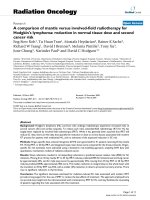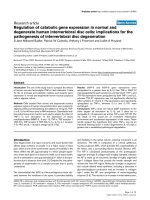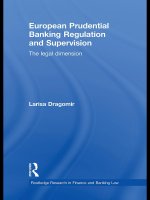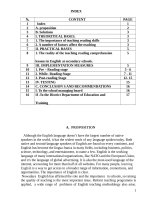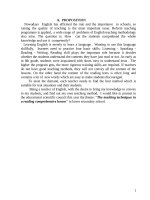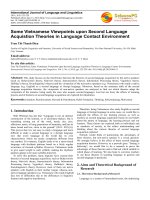Second dimension retention indices in “normal” orthogonality comprehensive two-dimensional gas chromatography using single standard injection generated isovolatility curves
Bạn đang xem bản rút gọn của tài liệu. Xem và tải ngay bản đầy đủ của tài liệu tại đây (1.1 MB, 5 trang )
Journal of Chromatography A 1683 (2022) 463548
Contents lists available at ScienceDirect
Journal of Chromatography A
journal homepage: www.elsevier.com/locate/chroma
Second dimension retention indices in “normal” orthogonality
comprehensive two-dimensional gas chromatography using single
standard injection generated isovolatility curves
Jason Devers∗ , David I. Pattison, Jan H. Christensen
Analytical Chemistry Group, Department of Plant and Environmental Science, Faculty of Science, University of Copenhagen, 1871 Frederiksberg C, Denmark
a r t i c l e
i n f o
Article history:
Received 5 April 2022
Revised 29 September 2022
Accepted 29 September 2022
Available online 1 October 2022
Keywords:
Comprehensive two-dimensional gas
chromatography
Retention index
Non-targeted analysis
Wastewater
Identification
a b s t r a c t
This work builds upon recent developments in the field of second dimensional (2D) retention indices (RI)
for use in comprehensive two-dimensional gas chromatography (GC×GC), expanding application to the
most commonly used “normal” orthogonality column configuration, where 2D RI are rarely employed.
Initially, one dimensional retention indices for 80 wastewater pollutants were determined by GC-MS on
a mid-polar ZB-50 column. In order to determine the 2D RIs for peaks detected in wastewater extracts
separated by GC×GC -MS, a single injection of a ten-compound standard mix allowed the construction
of model-generated isovolatility curves. These curves were used for the determination of 2D RIs of compounds initially identified on the basis of the mass spectral match factor and 1D RIs. Good agreements
(average deviation of 1.7%) were observed between the calculated 2D RIs and the measured reference RIs
for these compounds. These results show that this approach provides an additional level of confidence for
the identification of compounds detected in GC×GC-MS and demonstrates the potential of this approach
for improved compound identification in non-targeted analysis.
© 2022 The Author(s). Published by Elsevier B.V.
This is an open access article under the CC BY license ( />
1. Introduction
GC×GC has proven to be a powerful tool in the non-targeted
analysis of complex samples. The multiplicative peak capacity and
separation via two independent separation mechanisms in GC×GC
allows for the deconvolution, separation and therefore identification of peaks which may otherwise coelute using conventional
one-dimensional (1D) GC. [1] Retention indices (RI) are commonly
used in 1D GC to provide an additional level of confidence in the
identification of unknowns in addition to mass spectral information, [2,3] or as a primary identification tool in the absence of
mass spectral information. [4] The two-column setup of GC×GC offers the opportunity of using RIs in both the 1st and 2nd dimensions, allowing for the prediction of a compound’s elution position
within the 2D space. This additional identification criterion can increase confidence in detection by reducing the incidence of falsepositives in the non-targeted analysis of complex samples, such
Abbreviations: GC×GC, Comprehensive two-dimensional gas chromatography;
QTOF, Quadropole time-of-flight; RI, Retention Index; SPE, Solid phase extraction.
∗
Corresponding author at: Analytical Chemistry, Department of Plant and Environmental Sciences, University of Copenhagen, Thorvaldsensvej 40, Frederiksberg C,
Copenhagen 1871, Denmark
E-mail address: (J. Devers).
as wastewater. [2,5] However, while in 1D, RI is calculated based
on the relationship between an analyte’s retention time and the
retention times of reference compounds (often n-alkanes), [6] using the same approach for 2D RI is not applicable. This is a result
of the discrete nature of each 2D modulation, in which each second dimension separation occurs over only a few seconds as defined by the modulation time, and thus analytes are eluted under
pseudo isothermal conditions. [7] Recent solutions have included
the creation of 2D RI surfaces via the repeated injection of standards using several oven temperature ramp rates [8], and more
commonly, via the creation of isovolatility curves. These curves
are created by plotting the 2D retention time of a series of standards, when their 2D separation occurs at different 1D retention
times/pseudo isothermal separations. [9] Based on these generated
curves, it is then possible to determine the 2D RI of an analyte
based on its 2D retention time relative to the most closely eluting isovolatility curves. Generation of these isovolatility curves typically involves the continuous, [10] or repeated injection of a solution of n-alkanes, [11] fatty acid methyl esters (FAMES), or a combination thereof. [12]
Recent studies have demonstrated that the creation of these
curves can be completed using a single injection of a standard mix
whose retention times span the 2D separational space, which eliminates the need to regularly run complex continuous or multiple
/>0021-9673/© 2022 The Author(s). Published by Elsevier B.V. This is an open access article under the CC BY license ( />
J. Devers, D.I. Pattison and J.H. Christensen
Journal of Chromatography A 1683 (2022) 463548
injections [13]. Thus far, most of the research published on calculation of 2D RIs has been carried out using a “reverse” orthogonality
column setup, where a more polar column is used in the 1st dimension and a non-polar column in the 2nd dimension. [14] In this
case, the 2D RIs are based on separation on the non-polar column,
which gives two major advantages. Firstly, there is a large database
of reference RI values measured on non-polar columns for a wide
variety of compounds, approximately 10 0,0 0 0 values in the NIST
database, [15] and secondly, there is a lower observed retention
index deviation and superior chromatographic reproducibility for
non-polar columns compared to more polar columns. [16] However, in practice, a recent literature review shows that the vast
majority of GC×GC applications employ a “normal” orthogonality
setup, [17] i.e. using a non-polar column in the 1st dimension and
a more polar column in the 2nd dimension, thus there is a need to
increase the database of RIs on (mid-)polar columns, to provide a
method for more confident compound identification in GC×GC-MS
using a “normal” column orientation.
This study utilises a recently established method by Jiang et al.
2019 that generates isovolatility curves using a single injection of
a standard mix. [13] In this case, the approach is applied to a “normal” orthogonality column setup, which is a more popular GC×GC
configuration for non-targeted analysis of wastewater extracts. The
applicability and performance in this scenario have been assessed
by comparing reference RIs measured for standards by conventional GC-MS on a mid-polar column, with the 2D RIs determined
by the generated isovolatility curves, to provide confident identification of compounds in wastewater extracts.
ms. Ionization was carried out using an electron ionisation source,
operated at 230°C with an emission current of 35 μA and electron
energy of 70 eV.
The data for calculating (see Section 2.4) the reference RIs for
the mid-polar column were acquired by conventional 1D GC-MS,
using an Agilent 6890N GC coupled to an Agilent 5975B single
quadropole MS. Separation was carried out using a ZB-50 column
(60m, 0.18 mm i.d., 0.18 μm). Samples and standards of 1.0 μL
were injected splitless at an inlet temperature of 280°C. The primary oven temperature followed the program: initially 60°C for 1
minute, ramped to 320°C at a rate of 3°C/min, with a final hold
of five minutes, giving a total run time of 93 minutes. Helium was
used as the carrier gas with a constant flow rate of 1.0 mL/min.
2.3. Standard and Sample Preparation
Wastewater extracts were prepared using a multi-layer solid
phase extraction (ml-SPE) technique previously described by
Mechelke et al. 2019 and adapted by Tisler et al.2021 [18,19]. In
summary, wastewater samples were adjusted to pH 6.5 and filtered
using a Büchner vacuum filtration apparatus employing Whatman 1820-090 glass microfiber filters (Whatman, UK). Automated
SPE was then executed using a Promochrom SPE-03 system (Promochrom, Richmond, Canada) and ml-SPE cartridges comprised of
SupelcleanTM ENVI-Carb SPE cartridges (Sigma-Aldrich), Oasis HLB,
WAX and MAX sorbent SPE cartridges (Waters), resulting in 500
times enriched samples in methanol.
The ten-compound mixture used for generating isovolatilty
curves was prepared as described in table S-1 within the supporting information. The compounds were chosen based on preliminary non-targeted analysis of wastewater extracts, with compounds spanning as much of the two-dimensional space as possible, which allowed the isovolatility curves to be defined by data
points across the whole 2D separational space.
2. Experimental Section
2.1. Materials and Chemicals
An influent wastewater sample was sourced from a local
wastewater treatment plant (BIOFOS A/S, Avedøre, Denmark). LCMS grade methanol was sourced from Honeywell (Honeywell:
34966-2.5 L, Germany). Standard mixtures used for the generation
of isovolatility curves in GC×GC-MS and determination of reference RI by GC-MS were prepared in methanol, with the supplier
and solution information detailed in the supporting information for
the relevant solutions (Tables S-1 and S-2).
2.4. Data Processing
GC×GC-MS instrument data acquisition was performed via
Mass Hunter (Agilent, version: B.07.02.1938), and the interpretation of the resultant GC×GC-MS chromatograms using GC Image
(GC Image LLC, version: 2.9R1.1).
In-house reference RIs were generated using Automatic Mass
Spectral Deconvolution and Identification System (National Institute of Standards and Technology, Build: 149.31), automatically calculated based on the retention time of the compound of interest,
relative to the retention times of separately injected n-alkane standards, using the linear retention indices relationship established by
Dool and Kratz. [6] In addition, reference RIs were also sourced using the NIST_RI function contained within Webchem, an R (R Foundation, version: 3.6.2) package used to retrieve chemical information from online databases. [20]
2.2. Instrumentation
GC×GC-MS analysis was conducted using an Agilent 7890B GC
system coupled to an Agilent 7200 Accurate Mass QTOF mass spectrometer (Agilent Technologies, Palo Alto, CA, USA). The instrument was adapted for two-dimensional separation using a secondary column oven paired with a Zoex ZX2 cryogen free looptype modulator (Zoex Corporation, Houston, TX, USA). Separation
was carried out using a “normal” orthogonality column set, comprising of a non-polar ZB-5 column in the first dimension (60 m,
0.25 mm i.d., .25μm), and a mid-polar ZB-50 column (1.5 m, 0.18
mm i.d., 0.18 μm) in the second dimension (Phenomenex, Torrance, CA, USA). SilTite μ-union ferrules (SGE Analytical Science,
Wetherill Park, Australia) were used to connect the columns.
Samples and standards of 1.0 μL were injected using a 10:1
split ratio at an inlet temperature of 280°C. The primary oven temperature followed the program: initially 60°C for 1 minute, ramped
to 315°C at a rate of 3°C/min, with a final hold of ten minutes,
giving a total run time of 96 minutes. Secondary oven and hot
jet temperature were operated at a constant temperature offset
of + 60°C from the primary oven, with the column temperature
plateauing at 315°C and the hot jet at 360°C. Helium was used as
the carrier gas with a constant flow rate of 2.0 mL/min. The modulation period was set to 80 0 0 ms, with a hot jet on-time of 850
2.5. Generation of isovolatility curves using single injection of
standard mix
Log(log(2 tR )) = c
2
I
100
+ d ln
2
T + e
2
I
100
+f
(1)
Equation (1) was developed by Jiang et al. 2019, [13] and was
used here to establish the relationship between the observed 2D
retention time (2 tR ), reference retention index (2 I) and corresponding 2D elution temperature (2 T, determined by the 2D column oven
temperature corresponding to the peak’s 1D elution time) of the
reference compounds. Using the relevant variables detailed above
for each standard, yielded from a single injection of the standard
2
J. Devers, D.I. Pattison and J.H. Christensen
Journal of Chromatography A 1683 (2022) 463548
Fig. 1. (a) GC×GC-MS chromatogram of a single injection of the RI standard mix, with each of the ten standards labelled; (b) n-alkane isovolatility curves generated via
equation (1) using the 2 tR , 2 I and 2 T of the standards in the chromatogram.
mix, the equation was solved to determine the coefficients c, d, e
and f, using the COIN-OR CBC linear solver contained within the
OpenSolver plugin of Microsoft Excel. The solved coefficients were
then substituted into equation (1), in conjunction with the known
variables 2 tR , 2 T to calculate the experimental RI (2 I) for each analyte of interest.
expected due to the lack of equivalence between the wax-type
columns and a phenyl siloxane ZB-50 column. This observation
highlighted the need to determine more relevant RIs for both our
standards and compounds of interest on the column type used in
our studies. Thus, standards were prepared for the in-house determination of reference RIs for 80 compounds that were of interest in wastewater samples using the mid-polar ZB-50 column
via 1D-GC-MS. The resulting RIs for these 80 standards are given
in the supporting information (Table S-2). The use of these accurate reference RIs for our ten-compound standard mix allowed
the constants in equation (1) to be solved (c=-0.12, d=-0.19, e=
0.78 and f=1.36),and subsequently construction of hypothetical nalkane isovolatility curves for our GC×GC conditions, as illustrated
in Fig. 1 (b).
3. Results and Discussion
In order to test the creation of standard mix generated isovolatility curves as described by Jiang et al. [13] but using a “normal” orthogonality column setup, the ten-compound standard mix
was analysed using GC×GC-MS, as shown in Fig. 1 (a). The standard mix was run before and after samples to ensure that no significant drift in 2 tR occurred within the sequence, and a drift of
<0.1 s was observed for all compounds. The isovolatility curves
were generated from these data by solving equation (1) to obtain
the coefficients, and of equation (1) requires reference RI for the
compounds in the standard mix. The NIST database was searched
both manually and using the NIST_RI function in Webchem [20] in
order to retrieve reference RIs for both the standard compounds
and other compounds of interest in wastewater acquired using a
mid-polar column. However, this approach returned polar RIs determined primarily on wax-type stationary phase GC columns, in
contrast to the phenyl siloxane phase of the ZB-50 used in these
studies. It was not possible to solve equation (1) using the reference RIs determined on wax-type polar columns, which is to be
3.1. Application of isovolatility curves in non-targeted analysis of
wastewater extracts
In order to validate these model-generated isovolatility curves,
the relationship between our reference RIs from 1D GC-MS and the
RIs calculated from the isovolatility model in GC×GC-MS was investigated. Within the same sequence as the standard mix, an injection of an influent wastewater ml-SPE extract was carried out.
This chromatogram was imported and analysed within GC Image
and is shown in Fig. 2. A blob table for the wastewater extract was
exported which included all peaks with a signal to noise (S/N) ratio of >100. The compound identification for each peak in the blob
3
J. Devers, D.I. Pattison and J.H. Christensen
Journal of Chromatography A 1683 (2022) 463548
Fig. 2. GC×GC-MS chromatogram of influent wastewater ml-SPE extract, with identified compounds (n=20) labelled and highlighted in light blue.
The absolute (2D RI) values range from 2 - 81, with 14 out of 20
having (2D RI)<50, and 17 out of 20 with (2D RI)<60. Thus,
these data demonstrate that the use of similar (2D RI) criteria,
possibly with slightly more relaxed limits to those used in the first
dimension (where RI<40), can be used to further enhance confidence in compound identification in complex mixtures.
4. Conclusion
This study has demonstrated that the method of Jiang et al used
to generate isovolatility curves for 2D RI calculation in “reverse” orthogonality GC×GC-MS studies is also applicable to studies using
the more popular “normal” orthogonality column setup. In these
studies, a non-polar (ZB-5) column was use in the first dimension,
and a mid-polar, 50% phenylsiloxane (ZB-50) column was used in
the 2nd dimension. Eighty reference RI values (on a ZB-50 column)
have been reported for compounds that are commonly found in
wastewater, and Jiang’s isovolatility curve approach has been used
to calculate the 2D RIs for twenty compounds initially identified
in GC×GC-MS studies of a wastewater extract. A strong correlation was observed between the reference RIs and those measured
in the wastewater extract. Thus, the use of 2D RIs, in addition to
1D RIs and high spectral match factors (>700), allows additional
confidence in the identification of compounds in complex matrices
such as wastewater.
These studies highlight the value of using this approach for improving the confidence in identification of unknown compounds
in non-targeted analysis, using a “normal” orthogonality column
setup. Given the popularity of using phenylsiloxane type mid-polar
columns as a second-dimension column in “normal” orthogonality GC×GC, it is clear that there is a need for a more extensive
database of reference RIs on these column types. As the majority
of RI values available on polar columns are for wax-based stationary phases, the data suggest that there should be an onus on generating reference RIs for compounds on phenylsiloxane-based midpolar columns, to further enhance the possibilities of non-target
screening using GC×GC approaches
Fig. 3. Correlation of the 2D RIs of the compounds initially identified and labelled
in Fig. 2. Graph shows the 2D RIs determined from the isovolatility curves plotted
against the in-house reference RIs of the corresponding standards. The linear trendline gives a correlation coefficient (R2) of 0.9916, and a slope of 0.9735. The data
labels correspond to the individual compounds as shown in table 1.
table was initially based on its highest NIST match factor, with a
threshold defined by a match factor >700, and a RI (1D, on the
non-polar ZB-5 column) of <40 between reference (NIST) and the
experimentally observed RI value. Subsequently the 2D RI value
was calculated from the isovolatility curves (shown in Fig. 1b) for
each of the identified compounds listed in the blob table (labelled
in Fig. 2). The calculated 2D RIs from the wastewater extract were
then compared to the measured reference RI values (using the 80
standards detailed in Table S-2). The correlation between the RIs
calculated for the initially identified compounds in the wastewater
extract and the in-house reference RIs is shown in Fig. 3, and the
absolute values are given in Table 1.
The correlation coefficient (R2 ) of 0.9919 observed between
our model-determined RI and a fully independent validation set,
demonstrates a good predictability of RI within the relatively short
2nd dimensional separation using a mid-polar column. This correlation is lower than the value of 0.9997 observed by Jiang et al
[13] using the approach with a “reverse” orthogonality column
setup, but still displays good linearity. The lower correlation coefficient observed in our study compared to that measured by Jiang
et al [13] may be attributed to the greater variability that is generally observed in RI values measured on polar columnscompared to
non-polar columns, as previously reported [16]. The deviations observed between reference RIs and the model-determined RI values
for the twenty compounds identified in the wastewater extracts
were between 0.1% and 3.9%, with an average deviation of 1.7%.
5. Author Contributions
The manuscript was written through contributions of all authors. All authors have given approval to the final version of the
manuscript.
4
J. Devers, D.I. Pattison and J.H. Christensen
Journal of Chromatography A 1683 (2022) 463548
Table 1.
Compounds identified in influent wastewater extract, with corresponding label, 1D and 2D retention times in min and s respectively, reference (NIST) and experimental 1D
RI with the absolute difference ( ) for the respective compound reference (in-house, table S-2) and model-calculated 2D RI with the absolute ( ) and percentage difference.
Compound
Label
RT 1 (min)
RT 2 (s)
1D RI Ref
1D RI Exp
Benzothiazole
Benzeneacetic acid
Decanoic acid, methyl ester
Hydrocinnamic acid
1H-Indole, 2-methylDodecanoic acid, methyl ester
Diethyl Phthalate
Ibuprofen
Acetaminophen
2-Hydroxyibuprofen
Theobromine
1,7-Dimethylxanthine
Lidocaine
Hexadecanoic acid, methyl ester
n-Hexadecanoic acid
Dibutyl phthalate
9-Octadecenoic acid (Z)-, methyl ester
Fluoranthene
Methyl stearate
Oleic Acid
1
2
3
4
5
6
7
8
9
10
11
12
13
14
15
16
17
18
19
20
22.73
23.80
27.00
27.67
29.80
35.40
38.20
39.27
42.20
45.00
48.20
48.47
49.27
49.93
51.00
51.13
55.40
56.07
56.20
57.27
3.76
3.25
1.94
3.38
3.93
1.98
3.67
2.83
5.78
3.55
6.25
6.50
3.42
1.98
2.19
3.21
2.11
4.69
1.98
2.15
1228
1262
1326
1356
1398
1526
1594
1626
1703
1787
1874
1912
1878
1926
1968
1965
2085
2059
2128
2141
1231
1259
1341
1359
1414
1559
1631
1659
1734
1807
1890
1896
1917
1934
1962
1965
2076
2093
2096
2124
Supporting Information
1D RI
3
3
15
3
16
33
37
33
31
19
16
16
39
8
6
0
9
34
32
17
2D RI Ref
2D RI Model
1511
1486
1440
1586
1697
1644
1915
1859
2183
2119
2452
2468
2246
2044
2114
2293
2251
2549
2263
2332
1509
1498
1384
1601
1694
1588
1906
1849
2147
2101
2371
2391
2230
1986
2083
2270
2206
2592
2191
2285
2D RI
2
12
56
14
3
56
10
10
36
17
81
78
16
58
31
22
45
43
72
46
2D RI (%)
0.1%
0.8%
3.9%
0.9%
0.2%
3.4%
0.5%
0.5%
1.6%
0.8%
3.3%
3.1%
0.7%
2.8%
1.4%
1.0%
2.0%
1.7%
3.2%
2.0%
[6] H. van Den Dool, P. Dec-Kratz, A generalization of the retention index system
including linear temperature programmed gas-liquid partition chromatography, J. Chromatogr. A. 11 (1963) 463–471, doi:10.1016/s0021-9673(01)80947-x.
[7] S. Bieri, P.J. Marriott, Dual-injection system with multiple injections for determining bidimensional retention indexes in comprehensive two-dimensional
gas chromatography, Anal. Chem. 80 (2008) 760–768, doi:10.1021/ac071367q.
[8] M.A.I. Prodhan, A.A. Sleman, S. Kim, C. McClain, X. Zhang, Generalization of
Reference System for Calculating the Second Dimension Retention Index in
GC × GC–MS, J. Anal. Test. 2 (2018) 263–273, doi:10.1007/s41664- 018- 0074- 4.
[9] R. Jaramillo, F.L. Dorman, Thermodynamic modeling of comprehensive two dimensional gas chromatography isovolatility curves for second dimension retention indices based analyte identification, J. Chromatogr. A. 1622 (2020)
461111, doi:10.1016/j.chroma.2020.461111.
[10] J. Beens, R. Tijssen, J. Blomberg, Comprehensive two-dimensional gas chromatography (GC x GC) as a diagnostic tool, HRC J. High Resolut. Chromatogr.
21 (1998) 63–64, doi:10.1002/(SICI)1521-4168(19980101)21:1 63::AID-JHRC63
3.0.CO;2-P.
[11] M. Jiang, C. Kulsing, Y. Nolvachai, P.J. Marriott, Two-dimensional retention indices improve component identification in comprehensive two-dimensional
gas chromatography of saffron, Anal. Chem. 87 (2015) 5753–5761, doi:10.1021/
acs.analchem.5b00953.
[12] C. Von Mühlen, P.J. Marriott, Retention indices in comprehensive twodimensional gas chromatography, Anal. Bioanal. Chem. 401 (2011) 2351–2360,
doi:10.10 07/s0 0216- 011- 5247- 1.
[13] M. Jiang, Facile approach for calculation of second dimensional retention indices in comprehensive two dimensional gas chromatography with single injection, Anal. Chem. 91 (2019) 4085–4091, doi:10.1021/acs.analchem.8b05717.
[14] M. Adahchour, J. Beens, R.J.J. Vreuls, U.A.T. Brinkman, Recent developments in
comprehensive two-dimensional gas chromatography (GC × GC). II. Modulation and detection, TrAC - Trends Anal. Chem. 25 (2006) 540–553, doi:10.1016/
j.trac.20 06.04.0 04.
[15] N. Epa, N.I.H. Mass, S. Library, V.Z. Ei, J.a Sparkman, NIST Standard Reference
Database 1A, Natl. Inst. Stand. Technol. NIST. (2004) 1–49 />srd/.
[16] J. Zhang, A. Fang, B. Wang, S.H. Kim, B. Bogdanov, Z. Zhou, C. McClain, X. Zhang,
IMatch: A retention index tool for analysis of gas chromatography-mass spectrometry data, J. Chromatogr. A. 1218 (2011) 6522–6530, doi:10.1016/j.chroma.
2011.07.039.
[17] P.H. Stefanuto, J.F. Focant, Sep. Sci. Technol, in: Columns and column
configurations, Elsevier Inc., (New York), 2020, pp. 69–88, doi:10.1016/
B978- 0- 12- 813745- 1.0 0 0 03-9.
[18] J. Mechelke, P. Longrée, H. Singer, J. Hollender, Vacuum-assisted evaporative
concentration combined with LC-HRMS/MS for ultra-trace-level screening of
organic micropollutants in environmental water samples, Anal. Bioanal. Chem.
(2019) 2555–2567, doi:10.10 07/s0 0216- 019- 01696- 3.
[19] S. Tisler, D.I. Pattison, J.H. Christensen, Correction of Matrix Effects for Reliable
Non-target Screening LC-ESI-MS Analysis of Wastewater, Anal. Chem. 93 (2021)
8432–8441, doi:10.1021/acs.analchem.1c00357.
[20] E. Szöcs, T. Stirling, E.R. Scott, A. Scharmüller, R.B. Schäfer, Webchem: An R
package to retrieve chemical information from the web, J. Stat. Softw. (2020)
93, doi:10.18637/jss.v093.i13.
Standard compounds (with individual concentrations used), reference compounds from wastewater suspect list and corresponding
retention indices (PDF)
Declaration of Competing Interest
The authors declare that they have no known competing financial interests or personal relationships that could have appeared to
influence the work reported in this paper.
Data availability
Data will be made available on request.
Acknowledgment
This study is a contribution to the VANDALF project under grant
agreement no 9067-0 0 032B and supported by the Innovation Fund
Denmark. Thanks to Mathias Blichert Jørgensen (BIOFOS A/S) for
providing the wastewater samples used for this study.
Supplementary materials
Supplementary material associated with this article can be
found, in the online version, at doi:10.1016/j.chroma.2022.463548.
References
[1] M. Adahchour, J. Beens, R.J.J. Vreuls, U.A.T. Brinkman, Recent developments in
comprehensive two-dimensional gas chromatography (GC × GC). I. Introduction and instrumental set-up, TrAC - Trends Anal. Chem. 25 (2006) 438–454,
doi:10.1016/j.trac.20 06.03.0 02.
[2] J.S. Lübeck, G.L. Alexandrino, J.H. Christensen, GC × GC–HRMS nontarget fingerprinting of organic micropollutants in urban freshwater sediments, Environ.
Sci. Eur. 32 (2020), doi:10.1186/s12302- 020- 00353- 2.
[3] V.I. Babushok, Chromatographic retention indices in identification of chemical
compounds, TrAC - Trends Anal. Chem. 69 (2015) 98–104, doi:10.1016/j.trac.
2015.04.001.
[4] T. Pang, S. Zhu, X. Lu, G. Xu, Identification of unknown compounds on the basis of retention index data in comprehensive two-dimensional gas chromatography, J. Sep. Sci. 30 (2007) 868–874, doi:10.1002/jssc.200600471.
[5] A.T. Lebedev, O.V. Polyakova, D.M. Mazur, V.B. Artaev, The benefits of high
resolution mass spectrometry in environmental analysis, Analyst 138 (2013)
6946–6953, doi:10.1039/c3an01237a.
5


